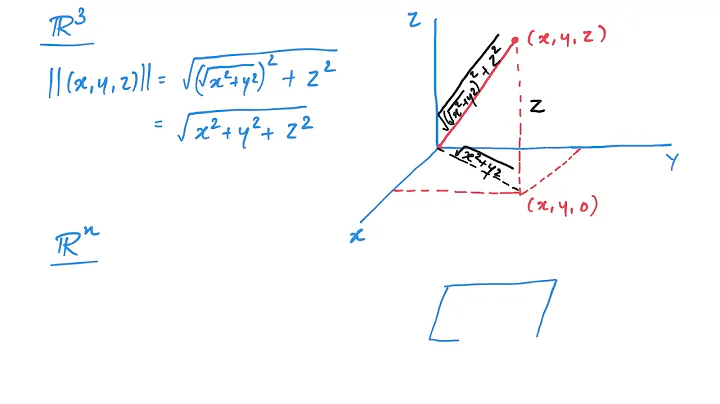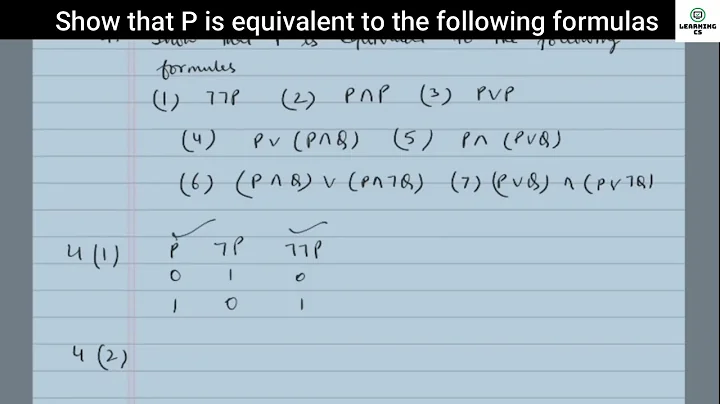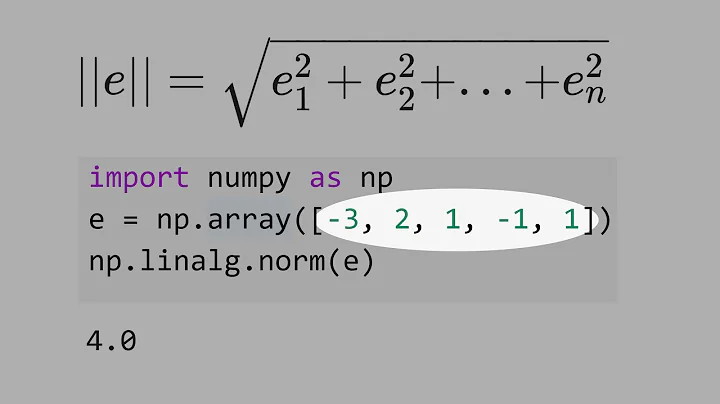Is "norm" equivalent to "Euclidean distance"?
Solution 1
A norm is a function that takes a vector as an input and returns a scalar value that can be interpreted as the "size", "length" or "magnitude" of that vector. More formally, norms are defined as having the following mathematical properties:
- They scale multiplicatively, i.e. Norm(a·v) = |a|·Norm(v) for any scalar a
- They satisfy the triangle inequality, i.e. Norm(u + v) ≤ Norm(u) + Norm(v)
- The norm of a vector is zero if and only if it is the zero vector, i.e. Norm(v) = 0 ⇔ v = 0
The Euclidean norm (also known as the L² norm) is just one of many different norms - there is also the max norm, the Manhattan norm etc. The L² norm of a single vector is equivalent to the Euclidean distance from that point to the origin, and the L² norm of the difference between two vectors is equivalent to the Euclidean distance between the two points.
As @nobar's answer says, np.linalg.norm(x - y, ord=2) (or just np.linalg.norm(x - y)) will give you Euclidean distance between the vectors x and y.
Since you want to compute the Euclidean distance between a[1, :] and every other row in a, you could do this a lot faster by eliminating the for loop and broadcasting over the rows of a:
dist = np.linalg.norm(a[1:2] - a, axis=1)
It's also easy to compute the Euclidean distance yourself using broadcasting:
dist = np.sqrt(((a[1:2] - a) ** 2).sum(1))
The fastest method is probably scipy.spatial.distance.cdist:
from scipy.spatial.distance import cdist
dist = cdist(a[1:2], a)[0]
Some timings for a (1000, 1000) array:
a = np.random.randn(1000, 1000)
%timeit np.linalg.norm(a[1:2] - a, axis=1)
# 100 loops, best of 3: 5.43 ms per loop
%timeit np.sqrt(((a[1:2] - a) ** 2).sum(1))
# 100 loops, best of 3: 5.5 ms per loop
%timeit cdist(a[1:2], a)[0]
# 1000 loops, best of 3: 1.38 ms per loop
# check that all 3 methods return the same result
d1 = np.linalg.norm(a[1:2] - a, axis=1)
d2 = np.sqrt(((a[1:2] - a) ** 2).sum(1))
d3 = cdist(a[1:2], a)[0]
assert np.allclose(d1, d2) and np.allclose(d1, d3)
Solution 2
The concept of a "norm" is a generalized idea in mathematics which, when applied to vectors (or vector differences), broadly represents some measure of length. There are various different approaches to computing a norm, but the one called Euclidean distance is called the "2-norm" and is based on applying an exponent of 2 (the "square"), and after summing applying an exponent of 1/2 (the "square root").
It's a bit cryptic in the docs, but you get Euclidean distance between two vectors by setting the parameter ord=2.
sum(abs(x)**ord)**(1./ord)
becomes sqrt(sum(x**2)).
Note: as pointed out by @Holt, the default value is ord=None, which is documented to compute the "2-norm" for vectors. This is, therefore, equivalent to ord=2 (Euclidean distance).
Related videos on Youtube
J_yang
Updated on June 14, 2020Comments
-
J_yang almost 4 years
I am not sure whether "norm" and "Euclidean distance" mean the same thing. Please could you help me with this distinction.
I have an
nbymarraya, wherem> 3. I want to calculate the Eculidean distance between the second data pointa[1,:]to all the other points (including itself). So I used thenp.linalg.norm, which outputs the norm of two given points. But I don't know if this is the right way of getting the EDs.import numpy as np a = np.array([[0, 0, 0 ,0 ], [1, 1 , 1, 1],[2,2, 2, 3], [3,5, 1, 5]]) N = a.shape[0] # number of row pos = a[1,:] # pick out the second data point. dist = np.zeros((N,1), dtype=np.float64) for i in range(N): dist[i]= np.linalg.norm(a[i,:] - pos) -
Holt over 8 yearsYou also get it with the default
Nonevalue. -
Brent Bradburn over 8 years@Holt: Thanks, I didn't notice that. The default is
Nonewhich computes the "2-norm", presumably matchingord=2. -
Brent Bradburn over 4 yearsSeems a shame to have all this discussion of the "2-norm" without mentioning it's most famous form: The Pythagorean theorem.
















